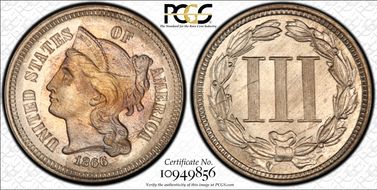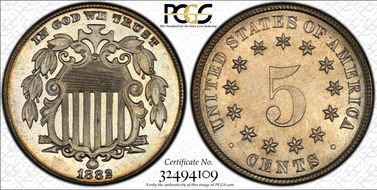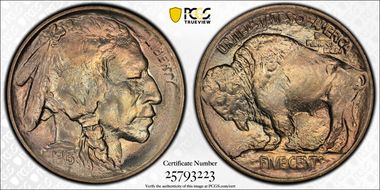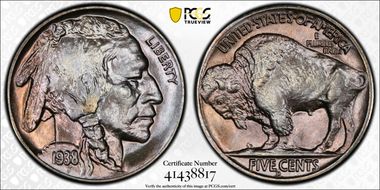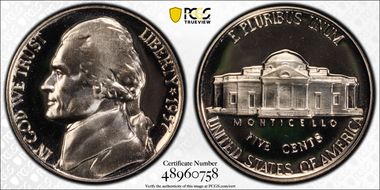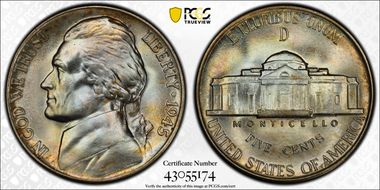Kazman54 - Nickel Type Set (1865-1964) 的钱币相册
Impressive cartwheel sheen and dusky caramel-gold toning confirm the originality of this unabraded and typically struck Premium Gem. A scarce type coin in such lofty grade, since the Rays design was used for only the initial two years of the nickel five cent piece. This piece is tied for the finest that PCGS has certified. Population: 57 in 66 (1 in 66+), 0 finer (10/19.
Impressive cartwheel sheen and dusky caramel-gold toning confirm the originality of this unabraded and typically struck Premium Gem. A scarce type coin in such lofty grade, since the Rays design was used for only the initial two years of the nickel five cent piece. This piece is tied for the finest that PCGS has certified. Population: 57 in 66 (1 in 66+), 0 finer (10/19.
Impressive cartwheel sheen and dusky caramel-gold toning confirm the originality of this unabraded and typically struck Premium Gem. A scarce type coin in such lofty grade, since the Rays design was used for only the initial two years of the nickel five cent piece. This piece is tied for the finest that PCGS has certified. Population: 57 in 66 (1 in 66+), 0 finer (10/19.
A sharply struck and highly lustrous SUPERB MS67 example of this late date Shield nickel. A totally unique looking coin that is among the FINEST KNOWN at PCGS. The obverse is distinctly Prooflike and flashy while the reverse is frosty and satiny. Sharply struck on both sides, the details stand out boldly and on the obverse they have a nice frosty texture. The eye appeal is very nice and has a great look. PCGS 9, NGC 7, CAC 6. The last PCGS-graded example sold for $3,720 in the 2019 ANA auction; there has not been a CAC-approved example sold in nearly five years. The current PCGS Price Guide value is listed at $4,500. Just two examples are graded MS67+ finer.
A sharply struck and highly lustrous SUPERB MS67 example of this late date Shield nickel. A totally unique looking coin that is among the FINEST KNOWN at PCGS. The obverse is distinctly Prooflike and flashy while the reverse is frosty and satiny. Sharply struck on both sides, the details stand out boldly and on the obverse they have a nice frosty texture. The eye appeal is very nice and has a great look. PCGS 9, NGC 7, CAC 6. The last PCGS-graded example sold for $3,720 in the 2019 ANA auction; there has not been a CAC-approved example sold in nearly five years. The current PCGS Price Guide value is listed at $4,500. Just two examples are graded MS67+ finer.
A sharply struck and highly lustrous SUPERB MS67 example of this late date Shield nickel. A totally unique looking coin that is among the FINEST KNOWN at PCGS. The obverse is distinctly Prooflike and flashy while the reverse is frosty and satiny. Sharply struck on both sides, the details stand out boldly and on the obverse they have a nice frosty texture. The eye appeal is very nice and has a great look. PCGS 9, NGC 7, CAC 6. The last PCGS-graded example sold for $3,720 in the 2019 ANA auction; there has not been a CAC-approved example sold in nearly five years. The current PCGS Price Guide value is listed at $4,500. Just two examples are graded MS67+ finer.
The 1938-D is the final issue in the Buffalo nickel series. Examples are plentiful through MS67, but MS68 coins are scarce. This ice-blue and lilac-gold example shimmers with original satin luster. Struck from fresh dies, the fields show no metal flow or clashing. Slight softness on the central high points is typical of the type. An ideal final-year type coin.
The 1938-D is the final issue in the Buffalo nickel series. Examples are plentiful through MS67, but MS68 coins are scarce. This ice-blue and lilac-gold example shimmers with original satin luster. Struck from fresh dies, the fields show no metal flow or clashing. Slight softness on the central high points is typical of the type. An ideal final-year type coin.
The 1938-D is the final issue in the Buffalo nickel series. Examples are plentiful through MS67, but MS68 coins are scarce. This ice-blue and lilac-gold example shimmers with original satin luster. Struck from fresh dies, the fields show no metal flow or clashing. Slight softness on the central high points is typical of the type. An ideal final-year type coin.




















